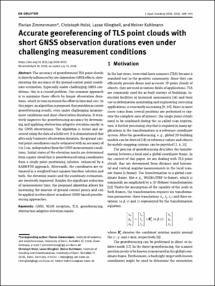Zimmermann, Florian; Holst, Christoph; Klingbeil, Lasse; Kuhlmann, Heiner: Accurate georeferencing of TLS point clouds with short GNSS observation durations even under challenging measurement conditions. In: Journal of Applied Geodesy. 12, 4, 289-301.
Online-Ausgabe in bonndoc: https://hdl.handle.net/20.500.11811/1441
Online-Ausgabe in bonndoc: https://hdl.handle.net/20.500.11811/1441
@article{handle:20.500.11811/1441,
author = {{Florian Zimmermann} and {Christoph Holst} and {Lasse Klingbeil} and {Heiner Kuhlmann}},
title = {Accurate georeferencing of TLS point clouds with short GNSS observation durations even under challenging measurement conditions},
publisher = {de Gruyter},
year = 2018,
month = aug,
journal = {Journal of Applied Geodesy},
volume = 12,
number = 4,
pages = 289--301,
note = {The accuracy of georeferenced TLS point clouds is directly influenced by site-dependent GNSS effects, deteriorating the accuracy of the ground control point coordinate estimation. Especially under challenging GNSS conditions, this is a crucial problem. One common approach is to minimize these effects by longer observation durations, which in turn increases the effort in time and cost. In this paper, an algorithm is proposed that provides accurate georeferencing results, even under challenging measurement conditions and short observation durations. It iteratively improves the georeferencing accuracy by determining and applying obstruction adaptive elevation masks to the GNSS observations. The algorithm is tested and assessed using the data of a field test. It is demonstrated that after only 5 minutes observation duration, the ground control point coordinates can be estimated with an accuracy of 1 to 2 cm, independent from the GNSS measurement conditions. Initial states of the elevation masks are determined from a point cloud that is georeferenced using coordinates from a single point positioning solution, enhanced by a RAIM-FDE approach. Afterwards, the coordinates are estimated in a weighted least-squares baseline solution and both, the elevation masks and the coordinate estimation, are iteratively improved. Besides the significant reduction of measurement time, the proposed algorithm allows for increasing the amount of ground control points and can be applied to other direct or indirect GNSS-based georeferencing approaches.},
url = {https://hdl.handle.net/20.500.11811/1441}
}
author = {{Florian Zimmermann} and {Christoph Holst} and {Lasse Klingbeil} and {Heiner Kuhlmann}},
title = {Accurate georeferencing of TLS point clouds with short GNSS observation durations even under challenging measurement conditions},
publisher = {de Gruyter},
year = 2018,
month = aug,
journal = {Journal of Applied Geodesy},
volume = 12,
number = 4,
pages = 289--301,
note = {The accuracy of georeferenced TLS point clouds is directly influenced by site-dependent GNSS effects, deteriorating the accuracy of the ground control point coordinate estimation. Especially under challenging GNSS conditions, this is a crucial problem. One common approach is to minimize these effects by longer observation durations, which in turn increases the effort in time and cost. In this paper, an algorithm is proposed that provides accurate georeferencing results, even under challenging measurement conditions and short observation durations. It iteratively improves the georeferencing accuracy by determining and applying obstruction adaptive elevation masks to the GNSS observations. The algorithm is tested and assessed using the data of a field test. It is demonstrated that after only 5 minutes observation duration, the ground control point coordinates can be estimated with an accuracy of 1 to 2 cm, independent from the GNSS measurement conditions. Initial states of the elevation masks are determined from a point cloud that is georeferenced using coordinates from a single point positioning solution, enhanced by a RAIM-FDE approach. Afterwards, the coordinates are estimated in a weighted least-squares baseline solution and both, the elevation masks and the coordinate estimation, are iteratively improved. Besides the significant reduction of measurement time, the proposed algorithm allows for increasing the amount of ground control points and can be applied to other direct or indirect GNSS-based georeferencing approaches.},
url = {https://hdl.handle.net/20.500.11811/1441}
}






